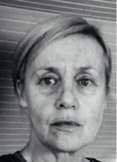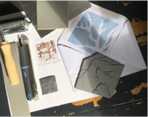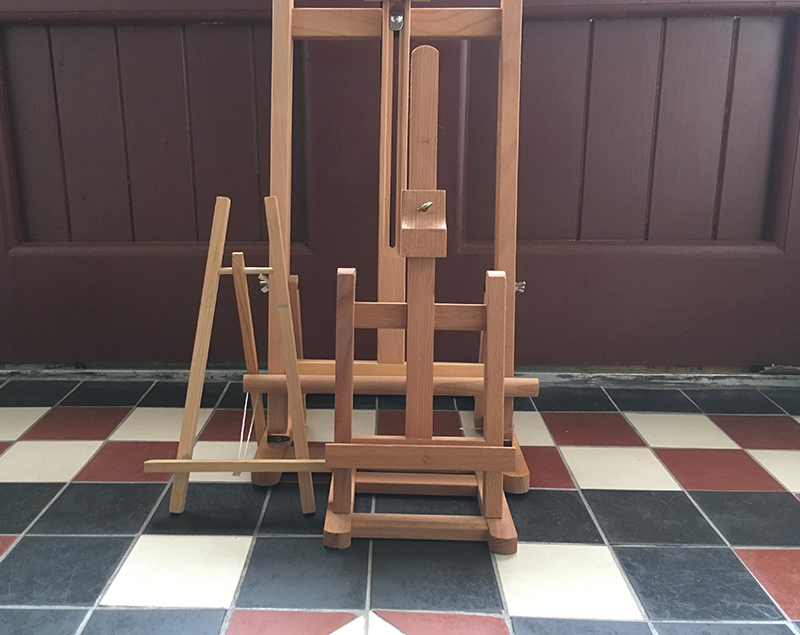ARTIST STATEMENT
 I work in oils, print and gouache. The subject matter of my work includes urban scape, landscape and still life. My immediate urban surroundings of old chimney pots, gable ends and rows of power lines feature regularly in my work. In my landscape paintings I try to reflect the splendid countryside of counties Clare, Galway and Limerick. The diverse terrain and changing skyline as seen from the train, motorway or bicycle presents me with endless dramatic vistas to work from. And as I attempt to capture it in my artwork I have tried to develop my own style of painting and a palette of muted tones. Over the past few years the industrial landscape has featured in my oil paintings. This subject matter has its own sense of drama and it also has a particular palette. The reds, greens and yellows of large cranes on the quay side of a busy port just demand to be painted and often the larger the better I think. My art is representational and I work at highlighting the contrasts I see around me, like industry as it sits into the countryside, light reflected off water or the setting sun on a gable end. There is no shortage of starting points, they don’t all make it to the finish but that’s ok too.
I work in oils, print and gouache. The subject matter of my work includes urban scape, landscape and still life. My immediate urban surroundings of old chimney pots, gable ends and rows of power lines feature regularly in my work. In my landscape paintings I try to reflect the splendid countryside of counties Clare, Galway and Limerick. The diverse terrain and changing skyline as seen from the train, motorway or bicycle presents me with endless dramatic vistas to work from. And as I attempt to capture it in my artwork I have tried to develop my own style of painting and a palette of muted tones. Over the past few years the industrial landscape has featured in my oil paintings. This subject matter has its own sense of drama and it also has a particular palette. The reds, greens and yellows of large cranes on the quay side of a busy port just demand to be painted and often the larger the better I think. My art is representational and I work at highlighting the contrasts I see around me, like industry as it sits into the countryside, light reflected off water or the setting sun on a gable end. There is no shortage of starting points, they don’t all make it to the finish but that’s ok too.
PRINTMAKING
 Printmaking is a general term used to describe different methods of creating an impression on a plate which is then inked up and printed. The methods I use to achieve my limited edition prints include Linocut and Drypoint and I print mainly on Fabriano 5 paper. With linocuts the smooth surface of lino is cut into. The lines and areas that are cut away will stay white on the finished print and the remaining islands of lino are inked up and printed. Lino is referred to as relief printing. It can be used in its basic form to great effect creating strong graphic images or several plates can be cut to create a multi coloured print.To make a Drypoint a sharp point is used to scratch a line into a piece of metal. Copper, zinc, steel or aluminum can be used. As the sharp point scratches into the metal plate it creates a ridge known as a burr. This holds the ink when the plate is printed and it gives the print a soft blurred quality which is the charming and unique quality of Drypoint printing. The possibilities within printmaking are endless whether a printmaker opts to use one method in its pure form or mix one with another. And when all the wonderful characteristics, which are unique to printmaking are brought to the gorgeous papers that are available the resulting piece of artwork will always give joy and entertainment to the viewer. Well what can I say, I love print.
Printmaking is a general term used to describe different methods of creating an impression on a plate which is then inked up and printed. The methods I use to achieve my limited edition prints include Linocut and Drypoint and I print mainly on Fabriano 5 paper. With linocuts the smooth surface of lino is cut into. The lines and areas that are cut away will stay white on the finished print and the remaining islands of lino are inked up and printed. Lino is referred to as relief printing. It can be used in its basic form to great effect creating strong graphic images or several plates can be cut to create a multi coloured print.To make a Drypoint a sharp point is used to scratch a line into a piece of metal. Copper, zinc, steel or aluminum can be used. As the sharp point scratches into the metal plate it creates a ridge known as a burr. This holds the ink when the plate is printed and it gives the print a soft blurred quality which is the charming and unique quality of Drypoint printing. The possibilities within printmaking are endless whether a printmaker opts to use one method in its pure form or mix one with another. And when all the wonderful characteristics, which are unique to printmaking are brought to the gorgeous papers that are available the resulting piece of artwork will always give joy and entertainment to the viewer. Well what can I say, I love print.
GOUACHE
 Gouache came about in the 16th century. It is a water based medium consisting of natural pigment, water and a binding agent. Gouache is opaque, unlike watercolour which is transparent, it can be re-wetted and it dries to a different value than it appears when wet. The final surface is matte and is chalky in appearance. The fast drying quality of gouache appealed to the Impressionist painters when they made ‘plein air’ or open-air painting popular in the 19th century.
Gouache came about in the 16th century. It is a water based medium consisting of natural pigment, water and a binding agent. Gouache is opaque, unlike watercolour which is transparent, it can be re-wetted and it dries to a different value than it appears when wet. The final surface is matte and is chalky in appearance. The fast drying quality of gouache appealed to the Impressionist painters when they made ‘plein air’ or open-air painting popular in the 19th century.
FRAMING
 The saying goes ‘clothes make the man ….’ well I think something akin to this can be said of the framing choices made for artwork. And there are many approaches that can be taken when selecting a frame. I have been framing for almost 20 years. I have learned by trial and error and I have got help and advice for other framers over the years along with attending framing and paint finishing courses. I use raw mouldings which are hand finished to give a bespoke frame that is tailored to the artwork. Basically framing is about enhancing the artwork and giving it the best possible level of protection. The fashion and interior design industries drive the changes in trends and colours used in framing. As much as possible I aim for a timeless look and see framing as ‘best supporting role’ to the artwork which is always the main event.
The saying goes ‘clothes make the man ….’ well I think something akin to this can be said of the framing choices made for artwork. And there are many approaches that can be taken when selecting a frame. I have been framing for almost 20 years. I have learned by trial and error and I have got help and advice for other framers over the years along with attending framing and paint finishing courses. I use raw mouldings which are hand finished to give a bespoke frame that is tailored to the artwork. Basically framing is about enhancing the artwork and giving it the best possible level of protection. The fashion and interior design industries drive the changes in trends and colours used in framing. As much as possible I aim for a timeless look and see framing as ‘best supporting role’ to the artwork which is always the main event.

